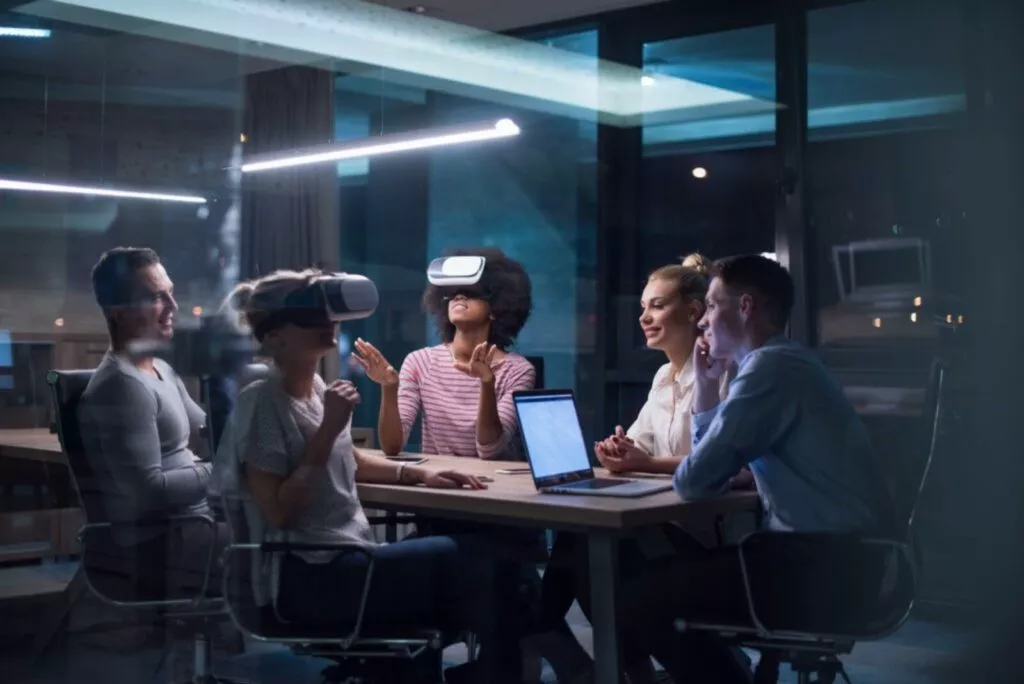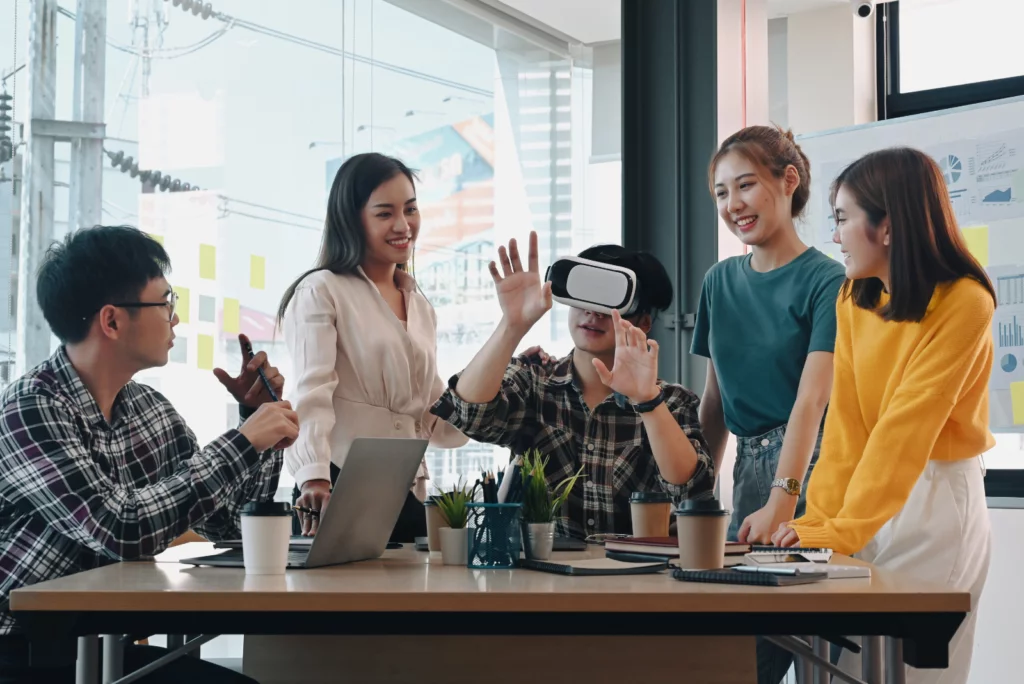Your cart is currently empty!
Augmented Reality Impact on Collaboration and Training Programs

In the pursuit of organizational excellence, training and development has undergone transformation, fueled by technological innovation. At the forefront of this transformative wave stands Augmented Reality (AR), a technological sensation poised to redefine the environment of collaborative learning. As organizations cope with the imperative to equip their workforce with ever-changing skills, AR emerges as a beacon of promise, reshaping traditional training standards and anticipating a new era of immersive and interactive learning experiences.
The merging of digital information with the physical world has unlocked unique possibilities for training programs, offering a dynamic fusion of the real and the virtual. This article explores the impact of Augmented Reality on collaborative training and development initiatives, dissecting the multifaceted ways in which this technology is changing the learning journey. From interactive learning environments and real-time collaboration to hands-on training simulations and personalized learning experiences, AR is catalyzing a seismic shift in how organizations cultivate the skills and knowledge of their workforce.
Augmented Reality (AR) is a technology that overlays digital information or computer-generated content onto the real-world environment. Unlike virtual reality, which immerses users in a completely simulated environment, AR enhances the real world with additional information, typically through devices like smart glasses, or AR headsets.
Relevance of Augmented Reality in Training
- Interactive Learning: AR provides a more interactive and engaging learning experience. Trainees can interact with digital content on physical objects, making the learning process more dynamic.
- Real-world Context: AR allows for training in real-world contexts. It overlays information onto the user’s immediate environment, enabling practical applications in fields such as maintenance, healthcare, and manufacturing.
- Simulated Hands-on Training: AR facilitates hands-on training without the need for physical equipment. Simulated scenarios can be created, allowing users to practice skills and procedures in a safe and controlled environment.
- Personalized Training: AR can be customized to individual learning needs. It adapts to the user’s pace and proficiency level, providing a customized learning experience that suits different skill levels.
- Remote Assistance: AR enables remote assistance by allowing experts to provide guidance and support from a distance. This is particularly valuable in fields where on-site expertise is crucial, such as field service or complex technical operations.
- Safety Training: AR is effective in safety training by simulating hazardous situations without exposing trainees to real risks. This is especially relevant in industries like construction, where workers can practice safety protocols in a virtual environment.
- Complex Procedure Visualization: AR can visualize complex procedures, making it easier for trainees to understand complex processes. This is valuable in medical training, where students can visualize anatomy or practice surgeries in a virtual setting.
See here for reference.

Real-world Examples of Augmented Reality Applications in Different Industries
- Healthcare (Surgical Navigation and Medical Training). AR assists surgeons by overlaying digital images onto the patient’s anatomy during surgery, providing real-time guidance. Medical students can use AR to practice surgeries and medical procedures in a simulated environment.
- Manufacturing (Assembly Line Assistance and Quality Control). AR can guide assembly line workers by providing visual instructions on the assembly process, reducing errors and increasing efficiency. AR can be used for quality control inspections by overlaying digital information on products to highlight defects or required adjustments.
- Education (Interactive Textbooks and Virtual Field Trips). AR enhances textbooks by overlaying additional multimedia content, providing a more engaging and interactive learning experience. Students can take virtual field trips using AR to explore historical sites, museums, or natural environments.
- Retail (Virtual Try-on and Virtual Navigation). AR allows customers to virtually try on clothing, accessories, or makeup before making a purchase. Retailers can use AR to guide customers within stores, providing information on product locations and promotions.
- Field Service (Remote Assistance and Equipment Maintenance). Technicians in the field can use AR to receive real-time guidance from experts located elsewhere, improving troubleshooting and problem resolution. AR overlays maintenance instructions onto equipment, facilitating on-the-spot repairs and reducing downtime.

The Future of Collaborative Learning with Augmented Reality
- Remote Collaboration and Telepresence. AR enables remote workers to collaborate as if they were physically present, using holographic representations or shared virtual workspaces for more immersive and effective collaboration.
- AR-enhanced Classroom Education. In traditional classrooms, AR can augment textbooks and lectures with interactive 3D models, animations, and additional information, making learning more engaging and dynamic.
- Virtual Conferencing and Training Events. AR can transform virtual conferences and training events by overlaying digital information, participant profiles, and interactive elements, creating a more engaging and collaborative experience.
- AR-driven Gamification for Learning. Gamification elements in AR applications can turn learning into a more enjoyable experience, encouraging collaboration and competition among learners to achieve educational objectives.
- Real-time Language Translation for Global Collaboration. AR can facilitate global collaboration by providing real-time language translation overlays during meetings, ensuring effective communication among team members who speak different languages.

How AR Enhances Collaboration in Training Programs and its Benefits
- Virtual Collaboration Spaces. AR enables the creation of virtual collaboration spaces where trainees can interact in real time. This promotes teamwork and communication, crucial elements in collaborative learning.
- Shared Augmented Environments. AR allows users to share a common augmented environment. In a training context, this could involve collaborative problem-solving or working on a shared project by overlaying digital elements onto a physical space.
- Remote Expert Assistance. AR facilitates real-time collaboration with experts regardless of their location. Trainees can receive guidance, support, or feedback from experts through AR, enhancing the overall learning experience.
- Interactive Simulations. Collaborative AR simulations enable teams to participate in interactive scenarios. For example, multiple trainees can work together in a simulated emergency response situation, enhancing their ability to collaborate under pressure.
- Digital Annotations and Markers. AR allows users to create and share digital annotations in real-world environments. In a training setting, this feature enables collaborative discussions and feedback by overlaying digital notes or markers onto physical objects.
Demonstrating the Positive Impact of AR on Collaborative Learning
- Boeing. Boeing utilized AR glasses for aircraft wire assembly, leading to a reduction in production time and a decrease in error rates. The implementation of AR resulted in increased first-time quality improvement.
- Stanley Black & Decker. Stanley Black & Decker incorporated AR into its manufacturing processes for hand tool assembly. The company states an increase in efficiency and a reduction in errors.
- University of Newcastle, Australia. The university implemented AR for collaborative learning in medical education. Students using AR reported increased engagement and collaborative problem-solving, leading to improved academic performance.

Implementing AR in Training and Development
- Assess Training Needs. Identify areas within the organization where AR can enhance training outcomes and collaboration. Focus on scenarios that benefit from interactive, immersive experiences.
- Invest in User-friendly Devices. Choose AR devices that are user-friendly and suitable for the training environment. Consider factors such as ease of use, comfort, and compatibility with existing systems.
- Develop Relevant Content. Create AR content that aligns with training objectives. Content should be interactive, engaging, and designed to encourage collaboration among trainees.
- Provide Adequate Training. Ensure that employees and trainers receive proper training on using AR devices and applications. Familiarity with the technology is crucial for effective integration into training programs.
- Encourage Collaboration. Enable a collaborative culture within the organization. Use AR to facilitate teamwork and communication among employees, emphasizing the benefits of collaborative learning.
Challenges and Considerations in AR Implementation
- Cost of Implementation. AR technology can involve significant upfront costs, including device purchases, software development, and training expenses.
- Technical Challenges. Organizations may face technical challenges, such as compatibility issues, network infrastructure requirements, and the need for ongoing technical support.
- Data Security and Privacy. AR involves the use of data, and organizations must address concerns related to data security and privacy, especially when dealing with sensitive information.
- Resistance to Change. Employees and stakeholders may resist the adoption of AR due to a fear of the unknown or a preference for traditional training methods.
- Content Development Complexity. Creating effective AR content requires specialized skills. Organizations need to invest in content development or collaborate with experts to ensure the quality of training materials.
- Integration with Existing Systems. Integrating AR into existing training systems and workflows can be challenging. Compatibility with other technologies and seamless integration are crucial for a smooth implementation.
- Maintenance and Updates. AR systems require regular maintenance and updates to ensure optimal performance. Organizations must establish processes for ongoing support and updates.
Addressing these challenges involves careful planning, communication, and a phased approach to implementation. Organizations should conduct pilot programs, gather feedback, and continuously refine their AR training initiatives to maximize their effectiveness.
Conclusion and Final Thoughts
Augmented Reality (AR) is reshaping collaborative training and development, offering a transformative solution to traditional challenges. While technology has improved accessibility, flexibility, and personalization in training, it has also introduced new obstacles. AR emerges as a powerful ally, providing interactive learning, real-world context, and hands-on training, addressing limitations of conventional methods.
Benefits of AR in Collaboration highlight its impact on virtual spaces, shared environments, and expert assistance. Case studies from Boeing, Stanley Black & Decker, and the University of Newcastle showcase tangible positive outcomes. Implementing AR requires strategic assessment, user-friendly devices, relevant content, training, and a collaborative culture, but challenges like cost, technical issues, and resistance must be navigated.
Augmented Reality, is poised to equip organizations with a skilled and interconnected workforce, ready for success in the dynamic business landscape.
Hands-On Application:
How does augmented reality enhance the effectiveness of collaborative training and development programs, and what specific benefits does it offer to participants and organizations alike? Get our hands-on application, highlighting the importance of augmented reality and its benefits. Click here!

Leave a Reply